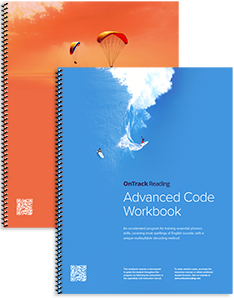Decisions Before Starting
OnTrack Reading Phonics Program
Teach your student the phonics advanced code in as little as 8 weeks with our 170-page workbook and instruction manual.
If you want to adapt the curriculum in The Writing Road to Reading to include the improvements suggested here, you will first need to make several decisions.
Purchase Basic Spalding Materials
You will need, at a mimimum, a copy of either the 4th or 5th edition of WRTR. You will be using about 95% of Ms. Spalding's curriculum directly, while modifying modest parts using the suggestions here. You will also need a supply of standard 6-sided pencils, some lined paper, the recommended sewn notebook, and probably a white board and markers for board work. If you decide to go with one of the commerical offerings, you will find much more available to purchase, but the basics here are all you actually have to have to fully utilize Spalding's curriculum. You will, of course, also need access to children's literature, whether purchased or borrowed from a library or friends. Much of this is accessible from Supplies You Will Need.
Decide Whether to Teach the /err/ Sound
Read this section of Rationale for Six New Phonograms and decide whether an /err/ sound should be included in your curriculum. If you decide against it, then just discard phonogram cards ere (#66), arr (#79) and err (#80). You will also then need to code the vowel sound in words where those phonograms are indicated in the Recoded Ayres List. For example, the word marry would be coded as marr y, with no numbering, indicating the first sound of the phonograms a and y are used. However, even if you do decide not to use the above three phonograms, you should still teach the phonograms ar and er to represent an /err/ sound in words like parish and perish if possible, so that "ar" and "er" remain digraphs in such words. (However, if parish and perish sound distinctly different in your area, you'll have to consider adjusting things to reflect "reality.")
Decide How to Code Ago, Along, Away, etc.
Ms. Spalding codes words like along and around as beginning with an /ae/ sound, for purposes of forming a "perfect pronunciation." Thus, a child should say "ay-long" and "ay-round" for spelling purposes. In my experience, having them think (and say) the third sound of the phonogram a, the /o/ sound (ah), is much closer to the actual pronunciation which is a schwa sound. Thus, I have always had a child think, and say, "ah-go," "ah-way," and "ah-round" when writing this sort of word. If you disagree, just change the coding from a 3 to a 2 as you encounter these words in the Recoded Ayres List.
Decide How to Code Yes, Yard, Yet, etc.
Ms. Spalding teaches a consonant sound of the phonogram y. Unfortunately it usually ends up being taught as "yuh" in isolation, and that simply isn't accurate. You might have to play with this a little to come to grips with it, but the consonant "y" pronunciation is actually a very clipped /ee/ sound. Try saying /ee/.../ar/.../d/. You'll find that you're saying "yard." Try it with /ee/.../e/.../s/, and you'll be saying "yes." The easiest way to handle this is to mention the quick, clipped /ee/ sound the first time you dictate a word for the notebook that begins with the phonogram y (word #27-you) and you'll see how easy it is. And fortunately, the first sound taught for the phonogram y is the /ee/ sound in this method, so it doesn't need any numbering. (Note, though, that the phonogram y at the begining of a word is a consonant sound, not a vowel sound. The vowel sound in yard is the /ar/ sound.)
Decide Whether to Change from Syllables to Chunking
The OnTrack Reading Multisyllable Method is unique, and exceptionally effective, and most of the suggested changes thus far actually do enable its use. However, I did say adoption of this method was optional, and it is. You can use the 84 revised phonograms and make all the suggested coding changes except for the syllable boundaries (staying with Ms. Spalding's syllables) if you wish. The discussion that might help you decide is located here, on the page titled A Note on Philosophy.
That concludes the decisions you'll need to make regarding changes to Romalda Spalding's original curriculum. Aside from these changes, you should follow her curriculum as she wrote it or, if you're using a commerical program, as instructed in that program. Next, you need to look at Modifying Spalding's Rules, depending upon the decisions you've made on the above issues.

